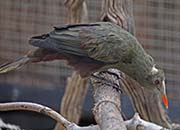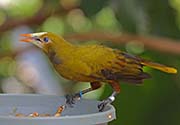Juvenile

Believe this is a juvenile
02/22/2012 - Phoenix Zoo, AZ
Believe this is a juvenile
02/22/2012 - Phoenix Zoo, AZ
|

Believe this is a juvenile
02/22/2012 - Phoenix Zoo, AZ
Believe this is a juvenile
02/22/2012 - Phoenix Zoo, AZ
|
|
Adult

04/11/2013 - Moody Gardens, Galveston, TX
04/11/2013 - Moody Gardens, Galveston, TX
|

04/11/2013 - Moody Gardens, Galveston, TX
04/11/2013 - Moody Gardens, Galveston, TX
|

03/06/2016 - San Antonio Zoo, TX
03/06/2016 - San Antonio Zoo, TX
|
Diet:
Eats insects, fruit and nectar.
Courtship:
The male swings to-and-fro from a branch as he displays his vibrant plumage
and sings.
He may also do a deep bow.
Nesting:
They breed in colonies of 5-30 nests.
The female builds a pouch shaped nest
at the tip of a branch which is woven from various plant materials.
The female usually lays 2 greenish-white eggs marked with browns and grays
and it is believed that she does all the incubation and feeding
while the male guards the nest.
Habitat and Range:
Green Oropendola inhabit tall humid undisturbed forests and are found in the
canopy and borders of forests.
They are found in Bolivia, Brazil, Colombia, Ecuador,
French Guiana, Guyana, Peru, Suriname, and Venezuela.
The Green Oropendola is distributed in the Amazon Basin
as far south as northern Mato Grosso.
Vocalization:
No information.
Plumage/Molt:
Does not have an alternate (breeding) plumage.
Migration:
Apparently sedentary.
Tongue/feet:
Black legs and feet.
Bibliography:
- http://en.wikipedia.org The Free Encyclopedia, Accessed June, 2012
- http://birdlife.org BirdLife International, Accessed June, 2012
- http://www.planteofbirds.com Planteofthebirds.com, Accessed June, 2012
- http://www.birds.cornell.edu The Cornell Lab of Ornithology, Accessed June, 2012
- del Hoyo, Josep, Elliott, Andrew, Sargatal, Jordi, et.al., Handbook of the Birds of the World,Lynx Edicions
Top of Page




